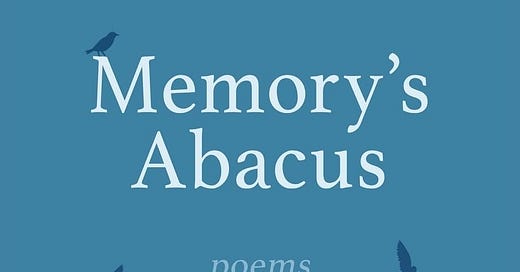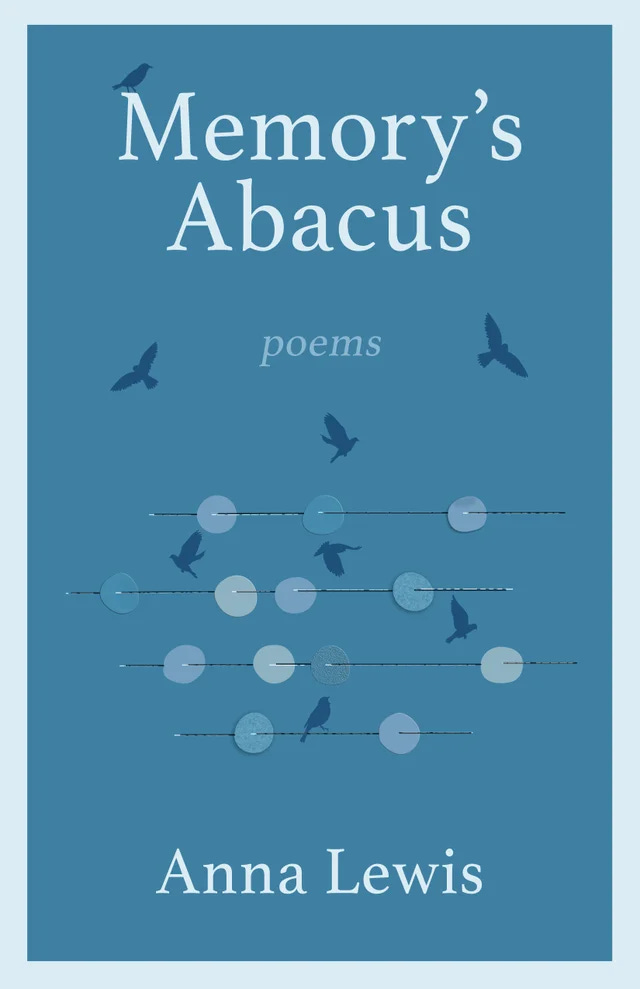Anna Lewis, Memory’s Abacus. Wiseblood Books, 2024.
Review by Zina Gomez-Liss
In Plato’s Phaedrus, Socrates expressed the belief that the invention of writing would destroy people’s memories and enfeeble their minds, denying them the ability to analyze information through live discourse. To a certain extent Socrates’ fears were reasonable, but written language was only the beginning of these troubles. He could not conceive of the innovations that would further alter mankind’s relationships with memory, perception, and critical thinking: the printing press, the gramophone, photography, movies, computers, the Internet, smartphones, and all the current innovations that are being developed faster than we can adapt to them or form any ethical code for their use.
The invention of writing was indeed disruptive, and what Socrates anticipated in Phaedrus was the incredible power it would have over a civilization. Despite the philosopher’s dire predictions, however, the written word has been a significant and positive advancement because it preserves information and ideas so that they are less subject to the corruption of bias or misremembering. It frees people’s minds to re-examine data and share it with others for further discussion. In an amusing bit of irony, the reason why we can speak of Socrates at all today is because his student Plato bothered to write things down. The written language did not destroy Homer’s epics; on the contrary, it gave people all around the world the Iliad and Odyssey in their original Greek or other desired languages on demand via pocket-sized computers thousands of years after they were first performed.
In a sense, Homer was a technologist of his own time, engineering lines of dactylic hexameter in a way to facilitate a rhapsode’s ability to recite long tracts of song and story. In the 10th century BCE, poets introduced rhyme into poetry which made memorization even easier. In his Introduction to The Wedge (1944), William Carlos Williams wrote that “a poem is a small (or large) machine made of words.” It is said that Robert Frost defined poetry as “a way of remembering that which it would impoverish us to forget.” Taken together I’ve come to believe that a poet is a kind of engineer, and his poems are machines of remembrance, language designed to capture and propagate the best of our culture so that it can be passed from generation to generation.
This tension between memory and modern invention is why I’ve been fascinated with Memory’s Abacus, the debut collection by North Carolina poet Anna Lewis. Using motifs ranging from Greek mythology to motherhood, Lewis helps us contemplate who we are, whom we love, and the tools by which we remember what is most important to us. She also explores how modern life affects our perspectives and ability to connect with one another, and she does this by using these memory machines called poems. Lewis deftly employs the music of metrical verse in a collection that displays a healthy variety of forms, such as the triolet, ballad, villanelle, and ghazal, but she tends to favor sonnets and short dimeter or trimeter lines—all to great effect.
Lewis’s most perfect use of form is in her titular poem “Memory’s Abacus,” which describes a grandmother tapping on a Christmas tablecloth as she remembers the names of her ten cousins who have died or moved away. This nineteen-line poem starts with one syllable for the first line and increases by one until her tenth line of ten syllables and then reduces by one until the last line is a single syllable. The visual result is a poem that looks somewhat like a triangle that points to the right, making the increase and decrease of the lines more striking. However, it is the auditory effect that is the most interesting. Once I recognized what was happening, I wanted to verify what I was hearing by using my own fingers to tap on my desktop to count off the number of syllables. Life has a way of imitating art.
The abacus itself is an early technology by which people grasp numerical functions by orders of ten. It is one invention we can use for knowing how much of what we have in the world. The grandmother’s fingers are her abacus, but her memory holds what is being quantified.
Dispersed now or dead, her childhood kin
reunite as a line of names
along her swollen knuckles. The cousins are not merely counted off but named and italicized for emphasis. In Genesis, Adam’s first creative task was to name all the animals. It is a sacred act, and one of great responsibility. Naming distinguishes a beloved from anyone else and makes them particular and special.
We are best able to remember people when we record their information in a lasting medium, like a name on a grave marker. “Cemetery Visit” is a poem that consists of 20 lines of blank verse which are separated in the middle by a single line, making the poem a total of 21 lines. It begins,
And here we are again, before your name
engraved in simple letters on this stone,
these markings we have known since early days—
arranged across the lines of every formThe shape of the poem evokes a rectangular gravestone with the 11th line, set off by line spacing, marking where the name of the deceased would be:
just so, your letters in their self-same row
Unlike the earlier poem where the grandmother mentions each of her cousins, the father's name in “Cemetery Visit” is not mentioned at all. There are times when knowing what someone is called is a sign of familiarity and intimacy. Withholding this information is an act of privacy that adds to the poignancy of this verse.
In Memory’s Abacus, names are used most conspicuously in the works inspired by Greek mythology. Characters like Arachne and Eurydice make appearances, but I am more fascinated in the verses where Lewis blends mythology with modern technology, such as “Narcissus Online,” which criticizes the selfie-staring culture of social media, and in “Persephone Calls Home,” where the poet explores the emotional distance between a child and parent when they become separated by time and distance. In “Persephone” the speaker recalls the abundance of conversation between herself and the parent, but then she mourns, “now we mainly speak on the phone. / Our words are few and tight, of little worth. / Each thin exchange reminds me I’m alone. / Each paltry effort indicates a dearth.” Although the title would imply an inevitable return to spring, this version of Persephone seems to be trapped in the loneliness of Hades.
The promises of technology to connect people and its failures to do so are also explored in “Solstitium” whose title suggests the changing of seasons, in this case, that of a friendship which has itself entered a solstice. In this poem, a friend takes a picture of a sunlit Brooklyn and sends it to another:
I aim my phone at city-squeezed radiance.
Where you are, you’ll hear a digital chirp,
the song of our long-distance alliance,
launched across networks to you on some perchHowever, the inadequacy of this act is succinctly put in the final couplet of this sonnet:
I send the sun via handheld device—
or almost—these pixels, inert as ice.Themes of alienation and grief are provided some counterweight by one of the most intimate human perspectives: motherhood. “Figment of Imagination” and “Passerby” speak of pregnancy and its physical awkwardness. “Morning Drop-Off” touches upon the separation anxiety between mother and child. However, no poem in this book comes as close to exploring the feelings of a young mother as “Reveries of a Mother on Foot,” a poetic sequence that comprises the entire second section of the book and consists of forty triolets. A difficult short form to master, the triolet is an 8-line poem where the first line is repeated in the fourth and seventh lines, and the second line is repeated in the last line. Furthermore, what Lewis does is create a “crown triolet” where the last line of the preceding triolet becomes the first line of the next triolet. By the fortieth triolet, which concludes the sequence, the last line is actually the first line of the very first triolet. If this sounds complicated, dear reader, it is. This work is what makes Memory’s Abacus stand out as a technical achievement and proof of Anna Lewis’s poetic talent.
If I have criticisms, they are minor. When a poet has so many triolets in succession a reader can see how some are not as strong as others, particularly in whether a repeated line’s meaning is transformed when it is seen again a few lines down. Also, “Reveries” is about a mother taking a long stroll with her baby in a carriage during which she daydreams, meditates on the joys of watching her baby grow, remembers moments of grief, dreads chores left at home, etc. It is, for this particular reader, an extremely long walk during which I’ve wondered whether the mother couldn’t have cut through someone’s yard. Some triolets seem like they could have been condensed or excised, thus giving the poetic section a little more focus. Despite these issues, “Reveries of a Mother on Foot” is incredibly successful.
Poets take various approaches on how they assemble their collections, and there is a particular thoughtfulness to Lewis’s ordering of Memory’s Abacus. The first poem of Part I begins with the view from an airplane (“Above It”) and is followed by a poem about Icarus’s fall from the sky (“Disappearing Act”). The elegy “April Funeral” is succeeded by “Memory’s Abacus” which ends with the word May, the name of a child that also happens to be the name of the month that follows April. The ballad “Childhood Home” sits opposite the sonnet “Persephone Calls Home”—two poems that mourn aspects of a childhood past. The book is full of these diptych-like experiences where pairs of poems face the reader on the page in a way that allows them to be contemplated together. Shared thematic elements like pregnancy, observing a scene with a friend, or mourning a death can be observed from slightly different poetic forms and narrative perspectives. The effect is not unlike seeing something with a pair of eyes. These slight changes in angle allow us to observe things with greater depth perception.
Memory still means as much to mankind now as it did in Socrates’ time. We just have more ways to store what we want to remember, and we have more information to sift through and judge what is memorable. Our minds and lives being finite, this discernment proves to be crucial. Great poets are keen observers who can help us see what is most important. Anna Lewis begins her book with “Winnower of Wheat to the Winds,” a translation of a French poem by Joachim du Bellay. A winnower can refer to either the person who separates wheat from chaff (sometimes by simply tossing the wheat into the wind) or the tool created to do this sorting. Just as the grandmother in “Memory’s Abacus” is the abacus, the poet is the winnower. She is an aid to memory, giving us the part of the harvest that would be most nourishing to us in a world starving for connection and beauty.
William Carlos Williams wrote, “There is no poetry of distinction without formal invention, for it is in the intimate form that works of art achieve their exact meaning, in which they most resemble the machine, to give language its highest dignity, its illumination in the environment to which it is native.” Anna Lewis creates many such machines in Memory’s Abacus—giving the craft of language and the significance of her subject matter their highest dignity and thus making them worthy of our remembrance.
Zina Gomez-Liss is a poetry student in the MFA program at the University of St. Thomas, Houston. She lives in Boston, MA, with her husband and five children. Zina's writing can be found on her substack, The Beauty of Things.





